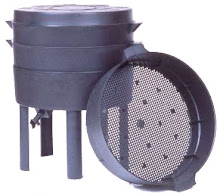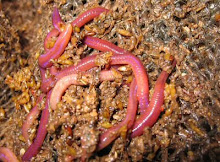
This semester, Hogwarts Academy generously provided me with a Wodehouse Sustainability grant to research vermicomposting: the act of using worms to break down organic wastes into rich vermicast, a nutrient-rich medium suitable for fertilizing one's garden. In other words, worm poop! The title of this blog, "Earth Dragon", comes from a Chinese term for earthworm: apparently, the Chinese have long employed earthworms in agriculture and admired the powers of this humble organism to generate rich soil with minimal maintenance.
On February 20, 2008, Glenn Martinez, proprietor of Olomana Gardens, set up a Can-O-Worms vertical continuous flow worm composting system in my classroom: an unassuming, black, rigid plastic tray with feet and a side spigot. Glenn, formerly an electrical contractor, started Olomana Gardens, an organic permaculture farm, in Waimanalo 12 years ago. The premise of permaculture: the farmer mulches the soil, scatters wood chips over all, tractor-tills the ground, then runs worms through it. The heat in the pile rises to an internal temperature of 170 degrees after 3-4 days and can spontaneously combust, as a result of methane buildup inside the pile--just in case you were thinking that farming was some bucolic, sedate activity. As an adjunct to permaculture farming, Glenn got into the worm business as a side-line, and now sells both composters and tillers.
Luckily, we were blessed to not have to purchase the two pounds of worms recommended by Glenn for optimal worm bin functioning, as they are spendy: a whopping $40/pound! Instead, A., a Hogwarts Grade 2 teacher, and the campus worm guru, generously shared "worm run"--the starter material containing our initial colony of worms--with us--a 7 year old messenger, face intent with purpose, arrived at the door of our classroom, bearing a large white bucket of worms.
Although redworms, also known as red wrigglers, are apparently the favored composting worm of choice in the continental United States, in Hawaii, the Hawaii Department of Agriculture sanctions only one type of worm for import into the state: Perionyx excavatus, also known as the Indian or Malaysian Blue Worm, which is suitable for tropical climes and hardy. If left alone, the Indian Blues migrate to another pile. Glenn claims that they are "like alley cats: they'll do anything to survive", unlike the red wrigglers, who will die if not fed. My students in attendance flinched when Glenn noted that this species of worm can grow up to 24" in length, and have grown as long as 6 feet in Australia. (Hmm...the latter story sounds suspiciously apocryphal to my ears, but that being said...) Composting worms are epigeic worms, surface dwellers that consume decaying organic matter on the surface of the ground, in contrast to endogeic worms, the subterreanean tillers that one normally pictures, when one thinks of earthworms. Glenn sells his tillers too, which were already on the premises of his property when he purchased it, at a hefty $2 per worm. Although that sounded pretty exorbitant to me, apparently the investment is worth it, as one worm alone can till 2 feet worth of hard clay soil.
So what's the big deal about Perionyx excavatus? Plenty. On the farm, Glenn described how the interns muck poop and pile it in a large heap in the barnyard. When they add five pounds of worms to said pile, they will eat all the way down in 90 days. That's a lot of soil!
The word "vermicast" derives from two languages: "vermi-"= Latin for worm; "cast" from Old Norse, "kasta"= to cast or throw. Glenn passed around a sample of the finished vermicast, and invited us to sniff it: very innocuous stuff, dark and rich like coffee grounds. Those present were greatly surprised to find that it had little smell, perhaps the faintest trace of rainforest, but little more.
Glenn also showed us a steel device called a "soil blocker", which shapes soil seed pots. Unlike seedlings in normal plastic pots, where watering expands and contracts pot, stunting the plant, seedlings planted in vermicast pots experience no dampening-off or transplant shock. All you have to do to get optimal results, Glenn explained, is dig a hole, put vermicast in hole, then plant the seedling. I chuckled when I saw Glenn's seed blocker, recalling the tour I'd taken of Hogwart's Public Service Center a few weeks earlier. The Center boasts a worm bin, and someone had left a number of seedling cubes constructed of vermicast in a foil-lined cardboard soda flat, right on top of the main table. If not for the slight round indentation on the top of each cube, it looked all for the world like an inviting pan of homemade chocolate cake: a dangerous proposition, with so many hungry students about, trolling for food!
I suppose that consuming said seedling cubes, other than being a nasty surprise, might actually be good for humans. Glenn noted that soil, prior to adding worms, generally possesses 8-14 nutrients: nitrogen, potassium, phosphorus, and other trace minerals. However, adding vermicast and worms produces a 700-800% increase in traceable elements in the soil. Interestingly enough, the vermicast apparently is relatively pathogen-free, even if the worms are fed manure. Glenn cited a statistic where human sewage was processed by worms, and in five days, scientists found it free of disease-carrying pathogens. Why? we're not sure: perhaps worms are selective and only eat the bad pathogens? And in the 2000 year or so history of using worm technology, Glenn said, no one has reported an infection from contact with vermicast--skeptic that I am, I mentally added "None reported, that is." But, that being said, Glenn's farm workers also deal with vermicast on a regular basis, and no one has gotten ill either. Some additional benefits to vermicast: if the worms receive a mixed diet, the castings are odorless, pH neutral,and unbuffered: they can be administered directly to plants without the burning associated with commercial chemical fertilizers.
The benefits of having a Can-O-Worms system like the one currently in place in my classroom: it's all-black, as worms are light-sensitive and like hanging out in the dark, and made from recycled plastic (#2: in case it broke down and you wanted to recycle the pieces, it could go in the "Mixed Containers" section of the City and County recycle bin). Supposedly, it'll keep everything odor-free if used indoors: I sure hope so! Structurally, there's a cone in the center of the bottom layer, and ventilation for aeration. The attached spigot at the base allows you to drain off the liquid which is a natural by-product of the decomposition process. The actual worms go in the second layer, which lies on top of the base. Initially, you need to provide them with bedding material: sawdust, shredded newspaper, or in our case, a commercial product designed especially for the Can-O-Worms system. The commercial bedding made of coir, or coconut husk, is sustainable; the peat moss that used to be the standard worm bedding material can't be exported anymore. The coir is compressed in a worm bedding block, which is pH neutral, fibrous, and holds moisture. The worms not only like lounging in it, but will also nibble on it, as well. To the bedding, one adds a bucket of worms: at least 2 pounds is optimal for this system. Worms enter puberty at four months of age; hermaphroditic, they mate head to tail. A worm lays approximately 10 eggs a week, which will hatch after 3 weeks.
So doing the math, 1000 worms will produce 10000 eggs after 10 weeks, creating exponential population growth. Food, in the form of organic waste, preferably pulverized or broken into small fragments, may be added, a large handful a day, in a circle. No more than 2 cm of food should be added over half the surface of the working tray. Apparently the worms do eat everything organic--apparently Glenn fed his a dead horse--but in indoor systems, you avoid feeding meat, dairy, or oily foods, to keep down the stench. Moist shredded paper is also added, as well as a damp cover (e.g. moistened newspaper, burlap) to help keep light out. The worms eat weight a day; pre-blending helps the worms eat better, but is not necessary. The air holes on cover let material aerate.
As the worms process the garbage into vermicast, the tray will fill up with the castings. Subsequent trays--2 more Working Trays in addition to the initial one--are added once the castings are 1/2 " above the plastic ribs on the inside of the tray. When the third Working Tray is filled, the first Working Tray is ready to empty: the contents will look like coffee grounds. Once emptied, the First Working Tray goes to the top, becoming the new Third Working Tray, and the process resumes again.
The large-scale applications? Glenn cited a local golf course that used to spend $350 a week to remove waste from its grounds, and which also produced lots of run-off from chemical fertilizers. Apparently, they've cut their maintenance costs from $1000 an acre per year to $80 an acre per year by using vermicast: it costs $1 for a pound of vermicast.
And obviously, there's major implications for a school like Hogwarts, which produces lots of organic waste. Obviously, if we're not able to convert the waste, it poses a major landfill problem, not to mention the monetary costs: approximately $1200/bag to process. As we live on an island, it's abundantly clear that we need to do something to save ourselves from becoming awash in garbage. I hope the worm bin represents a do-able step towards a more sustainable future, for ourselves and our posterity.

